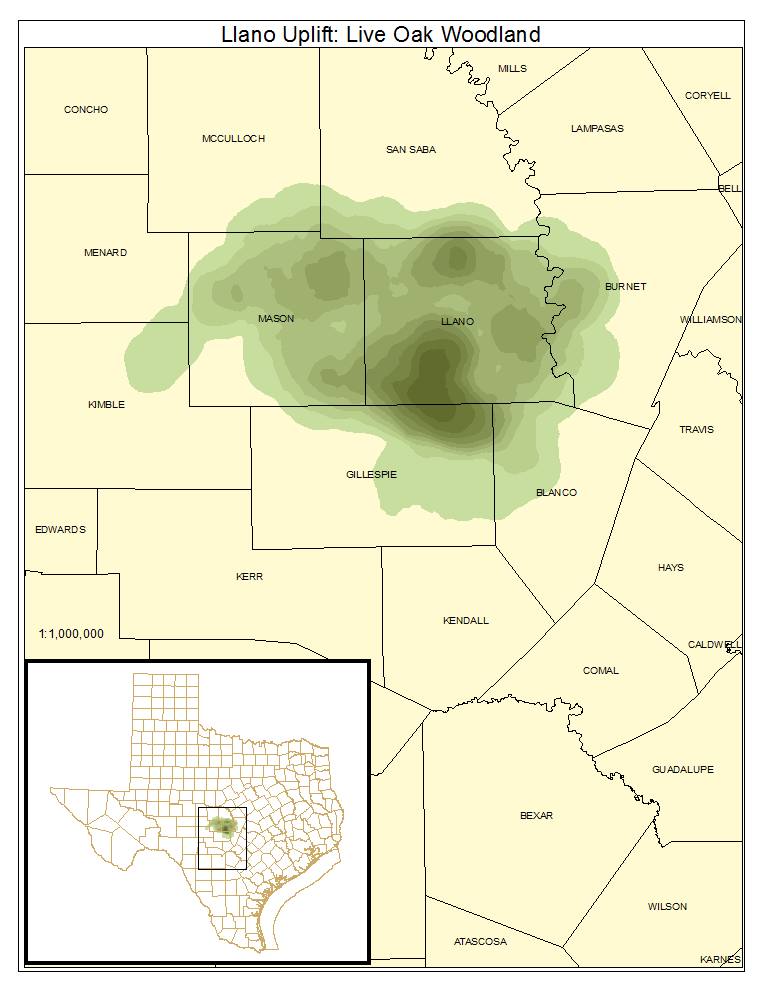Llano Uplift Acidic Forest, Woodland, and Glade
Geology
Intrusive igneous bedrock of Precambrian age.
Landform
Granite hills rising from a gently rolling landscape that is moderately dissected by drainages.
Soils
Generally sandy loams, with gravelly soils common. Soils are generally acidic and coarse, resulting from weathering of the underlying granite. Many areas of exposed bedrock are present. Most frequently encountered Ecological Sites include Shallow Granite, Sandy Loam, Red Savannah, Gravelly Sandy Loam, Shallow Ridge, Granite Gravel, Sandstone Hill, and Granite Hill.
Parent Description
It is comprised of a mosaic of vegetation types, including closed-canopy forests, open woodlands, savannas and sparsely vegetated rock outcrops. Common trees include Quercus marilandica (blackjack oak), Quercus fusiformis (plateau live oak), Quercus stellata (post oak), Carya texana (black hickory), Ulmus crassifolia (cedar elm), and Prosopis glandulosa (mesquite). Juniperus ashei (Ashe juniper) may be present, but is much less common than in the surrounding landscape. Subcanopy species may include Diospyros texana (Texas persimmon), Aloysia gratissima (whitebrush), Ungnadia speciosa (Mexican buckeye), Ziziphus obtusifolia (lotebush), Eysenhardtia texana (Texas kidneywood), Aesculus glabra var. arguta (Ohio buckeye), Opuntia engelmannii (prickly pear), Yucca elata (palmilla), Nolina texana (sacahuista), and Opuntia leptocaulis (tasajillo). Grasslands may be dominated by Schizachyrium scoparium (little bluestem), Sorghastrum nutans (Indiangrass), Panicum virgatum (switchgrass), Bouteloua hirsuta (hairy grama), Bouteloua curtipendula (sideoats grama), Nassella leucotricha (Texas wintergrass), Bothriochloa laguroides ssp. torreyana (silver bluestem), and Plantago wrightiana (Wright plantain). Granitic glades and barrens are sparsely vegetated by crustose and foliose lichens, several ferns and fern allies, and cacti. This system also includes small (up to 16 m in diameter) shallow depressions that hold rainwater and support wetland flora including the Texas endemic, Isoetes lithophila (rock quillwort).
Ecological Mapping Systems
Llano Uplift: Live Oak Woodland
Canopy conspicuously dominated by Quercus fusiformis (plateau live oak), this vegetation type forms the common forest and woodland cover in the uplift area. Juniperus ashei (Ashe juniper) may be present but generally occurs at lower cover than is typical of the surrounding limestones. Quercus stellata (post oak), Quercus marilandica (blackjack oak), Ulmus crassifolia (cedar elm), and Carya texana (black hickory) may also be present in the canopy, but Quercus fusiformis (plateau live oak) clearly dominates. Diospyros texana (Texas persimmon), Aloysia gratissima (whitebrush), Mahonia trifoliolata (agarito), Mimosa aculeaticarpa var. biuncifera (catclaw mimosa), Prosopis glandulosa (mesquite), and Opuntia engelmannii (prickly pear) are common shrubs in the understory. Schizachyrium scoparium (little bluestem), Bothriochloa laguroides ssp. torreyana (silver bluestem), Bouteloua hirsuta (hairy grama), and Bouteloua curtipendula (sideoats grama) are common constituents of the herbaceous layer. Schizachyrium scoparium (little bluestem) is a common dominant. Some areas may be dominated by Prosopis glandulosa (mesquite), often with thick understory shrubs of Aloysia gratissima (whitebrush).
Distribution Map

Photos

Llano Uplift: Post Oak Woodland
Forests and woodlands not dominated by Quercus fusiformis (plateau live oak) (though it is often present), are generally dominated by Quercus stellata (post oak), with Quercus marilandica (blackjack oak) and Carya texana (black hickory) also present to co-dominant. Ulmus crassifolia (cedar elm) and Celtis laevigata (sugar hackberry) may also be important components of the canopy. Shrubs and herbaceous cover are similar to those of the live oak woodland.
Distribution Map

Photos

Llano Uplift: Acidic Glade (not mapped)
Openings on exposed granitic outcrops are common throughout the region. They are characterized by foliose and crustose lichens representing the most significant cover. Cover is very sparse, but may include Selaginella peruviana (peruvian spikemoss), Selaginella arenicola ssp. riddellii (Riddell's spikemoss), Selaginella wrightii (Wright's spikemoss), Cheilanthes spp. (lipfern), Pellaea spp. (cliffbrake), Woodsia obtusa (common woodsia), Sedum nuttallianum (yellow stonecrop), Plantago wrightiana (Wright plantain), Allium canadense (Canada garlic), Hypericum spp. (St. John's-wort), Agrostis spp. (bentgrass), Vulpia octoflora (sixweeks fescue), Spermolepis inermis (spreading scaleseed), Lepidium spp. (peppergrass), and Tripogon spicatus (American fiveminute grass). Small depressions in the granite may hold water and have unique floristic elements associated with them.
Llano Uplift: Mesquite / Whitebrush Shrubland
On disturbed sites Prosopis glandulosa (mesquite) may dominate the canopy, forming a woodland overstory or, more commonly, representing a shrub layer. Quercus fusiformis (plateau live oak) may be present. Shrubs may form dense cover under the sparse canopy of mesquite. Species in the shrub layer commonly include Aloysia gratissima (whitebrush), Ziziphus obtusifolia (lotebush), Opuntia engelmannii (prickly pear), Colubrina texensis (Texas colubrina), and Diospyros texana (Texas persimmon). Some areas of high shrub abundance are clearly dominated by Aloysia gratissima (whitebrush) or Ziziphus obtusifolia (lotebush) in the shrub layer.
Distribution Map

Photos

Llano Uplift: Grassland
These relatively small patch grasslands may be dominated by native species such as Schizachyrium scoparium (little bluestem), Bouteloua curtipendula (sideoats grama), Bothriochloa laguroides ssp. torreyana (silver bluestem), Bouteloua hirsuta (hairy gramma), Aristida spp. (threeawn species), and/or Nassella leucotricha (Texas wintergrass). Scattered trees (typically Quercus fusiformis (plateau live oak) or Quercus stellata (post oak) may be present, as well as scattered shrubs (particularly Prosopis glandulosa (mesquite), Diospyros texana (Texas persimmon), or Aloysia gratissima (whitebrush)). Frequently non-native grass species such as Cynodon dactylon (Bermuda grass) or Bothriochloa ischaemum var. songarica (King Ranch bluestem) dominate the herbaceous layer.
Distribution Map

Photos
